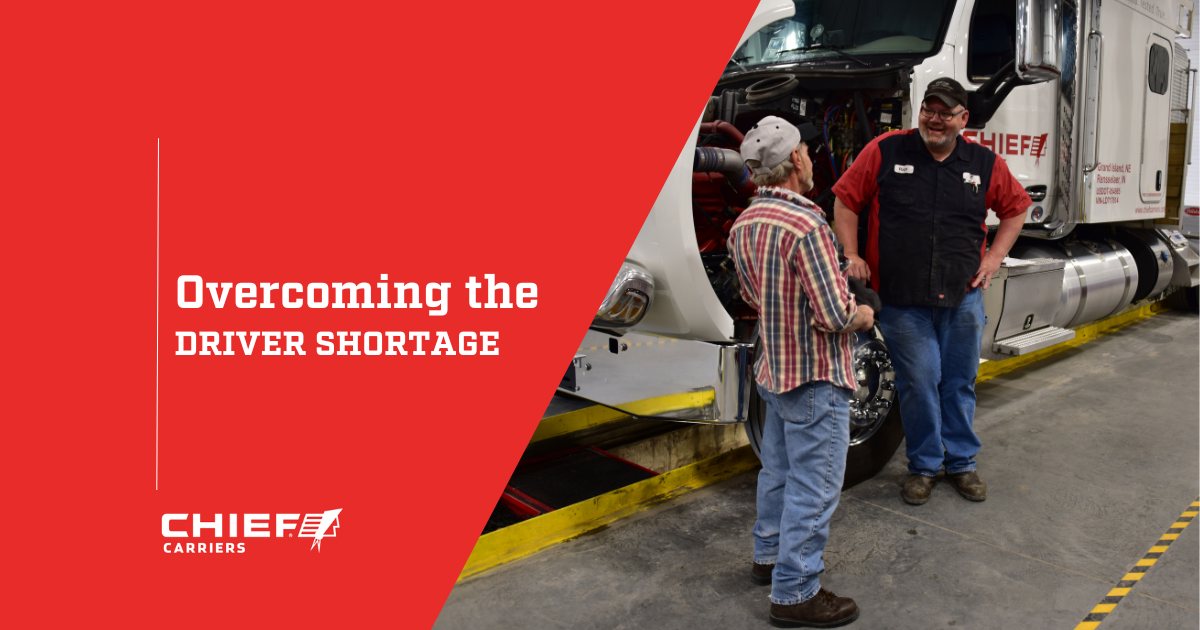How to Deal With Driver Shortage in Trucking
Today’s blog challenges the myth of a driver shortage in trucking, revealing the real issue: retention. It emphasizes the need for fair pay, respect, and better working conditions, advocating for industry-wide change to improve driver satisfaction and retention rates.
Hello again to all our dedicated readers and to those new to the “Driven Too Far” community. I’m Andrew Winkler, your guide through the intricate world of trucking, both on the road and off.
In this post, we’re exploring a topic that’s sparked endless debate within our industry: the purported driver shortage. This issue isn’t just about numbers; it’s about understanding the real challenges that lie beneath the surface.

Is There Really a Driver Shortage in Trucking?
In our latest podcast episode, we tackled the myth head-on, questioning the very existence of a driver shortage in trucking. With a critical eye, we explored the discrepancy between the number of active CDL holders and the supposedly vacant driving positions.
More importantly, we shed light on the persistent issues contributing to the cycle of high turnover and unfilled seats, challenging the narrative that there simply aren’t enough drivers out there.
Reflecting on my 30-year journey through the trucking industry, I’ve witnessed firsthand the evolution of driver expectations and how companies have struggled or succeeded in adapting.
I recall a time when the road was home for weeks on end, a stark contrast to today’s demand for a balance between work and family life. These observations underscore a significant shift in our industry, highlighting the need for change.
This blog extends the conversation from our podcast, providing truckers, whether newbies or seasoned veterans, with practical advice and deeper insights.
It’s about more than just discussing problems; it’s about advocating for real solutions, promoting better treatment for drivers, and pushing for higher standards across the industry.
We’re here to support and guide each other through these shared challenges.

Misconceptions About Driver Shortage
The narrative around driver shortages often misses the mark, focusing on quantity over quality.
We discussed the reality that there are indeed more CDL holders than open driving positions, suggesting the issue isn’t a shortage of drivers but rather a failure to retain them. High turnover rates tell a story of dissatisfaction and unmet needs, pointing to systemic problems within the industry that need addressing.
Industry Challenges Impacting Drivers
These are some of the things that affect the driver industry and turnover rates.
Inadequate Pay and Unrealistic Promises
Despite carriers’ promises of high earnings, many drivers face the harsh reality of salaries that do not match the demands of their roles. Unrealistic expectations set by employers lead to a vicious cycle of disappointment, contributing significantly to driver dissatisfaction.

Lack of Adequate Parking and Rest Facilities
The acute shortage of safe parking and adequate rest facilities presents a major challenge, adding unnecessary stress to drivers’ lives and jeopardizing their safety and compliance with Hours of Service regulations.
Insufficient Home Time
The quest for a work-life balance remains elusive for many in the trucking industry. Drivers crave more predictable schedules that allow for quality time at home, underscoring the need for systemic changes to accommodate these expectations.
Poor Treatment by Shippers and Receivers
Many drivers report disrespectful treatment by shippers and receivers, including being denied basic amenities like restroom access. This lack of respect exacerbates feelings of undervaluation within the profession.
Frustrations with Regulatory Environments
The trucking industry’s regulatory landscape is constantly shifting, with new rules often adding more burdens than benefits. This continuous state of flux contributes to a sense of instability and frustration among drivers, further detracting from the profession’s appeal.

Traits of Carriers with High Turnover
So, what else is affecting those high turnovers? The way we treat drives matters too.
Lack of Respect for Drivers
A common trait among carriers facing high turnover rates is their failure to treat drivers with the respect and dignity they deserve. These companies often view drivers not as valuable assets but as replaceable parts, leading to a culture where drivers feel undervalued and disposable.
Neglecting Drivers’ Need for Home Time
Ignoring the importance of home time is another critical mistake made by these carriers. Drivers are frequently promised adequate home time during recruitment but find the reality far removed from those promises. This breach of trust contributes to a deep sense of dissatisfaction, prompting drivers to seek employment elsewhere.
Practices Undermining Trust
Carriers with high turnover often engage in practices that severely undermine trust and driver welfare. This includes failing to honor pay agreements, imposing unrealistic work demands, and not addressing drivers’ concerns promptly. Such practices not only erode the foundational trust necessary for a healthy employer-employee relationship but also signal a lack of commitment to drivers’ well-being, further fueling turnover.

How Cheif Carriers Avoid Driver Shortage
So, by taking all the above into consideration, this is what we do differently to ensure employee retention.
Prioritizing Safety and Satisfaction
Successful carriers stand out by putting safety and driver satisfaction at the forefront of their operations. They recognize that ensuring the well-being of their drivers is not just a regulatory requirement but a core value that drives the entire company. This commitment to safety and satisfaction significantly reduces turnover rates.
Competitive and Fair Pay
These carriers understand the importance of offering competitive and fair pay programs that truly reflect the hard work and dedication of their drivers. By ensuring their compensation packages are among the best in the industry, they attract and retain top talent.
Opportunities for Career Growth
Another hallmark of successful carriers is their provision of clear paths for career advancement within the company. Whether through additional training, mentorship programs, or promotion opportunities, they invest in their drivers’ futures, encouraging long-term loyalty and professional development.

Open and Honest Communication
Maintaining a policy of transparency and open lines of communication is crucial. Good carriers regularly update their drivers on company news, policy changes, and industry developments, fostering a culture of trust and mutual respect.
Culture of Respect and Teamwork
Finally, the best carriers cultivate a workplace environment where respect and teamwork are paramount. They recognize that every member of the team, from drivers to dispatchers to office staff, plays a vital role in the company’s success, and they treat everyone with the respect and appreciation they deserve.
Strategies for Retention and Recruiting
Effective recruiting strategies are those that not only align with the needs and aspirations of drivers but also fit well with the company’s culture. Successful carriers take the time to understand what drivers value most—be it pay, home time, or career advancement opportunities—and tailor their offerings accordingly.
This alignment ensures that new recruits are a good fit for the company, promoting higher satisfaction and retention rates.
Selectivity and Honesty in Recruiting
Being selective and truthful during the recruitment process is paramount. Good carriers are transparent about job expectations, pay structures, and the realities of the role. This honesty helps set realistic expectations from the outset, reducing the likelihood of dissatisfaction and turnover. Moreover, by being selective, companies ensure they recruit drivers who are not only qualified but also likely to thrive within their specific work environment.
Leveraging Job Referrals
Job referrals from existing employees can be a goldmine for recruiting trustworthy and reliable team members. When drivers recommend their employer to peers, it speaks volumes about the company’s culture and working conditions. Such referrals often lead to a more cohesive and satisfied workforce, as new hires come with a pre-existing positive impression of the company. Furthermore, incentivizing referrals can encourage a culture of trust and community among team members, contributing significantly to overall retention efforts.

Final Thoughts
The narrative that the trucking industry is grappling with a driver shortage can be misleading. Our discussions reveal that the real issue at hand is not the lack of drivers but the industry’s struggle with retaining them.
This challenge stems from a series of systemic problems, including inadequate pay, insufficient home time, lack of respect, and poor working conditions.
It’s clear that for the industry to thrive, a shift towards more driver-friendly practices is imperative. Carriers that prioritize their drivers’ well-being, offer fair compensation, and foster a culture of respect and teamwork set a benchmark for success.
These practices not only improve retention rates but also enhance the overall attractiveness of trucking as a career.
We encourage all industry stakeholders to take these insights to heart and work towards creating a more sustainable and driver-focused industry. For a deeper dive into this topic and more actionable advice, I invite our readers to listen to the full episode of “Driven Too Far: The Truth About Trucking” podcast.
Together, let’s drive towards a future where trucking is not just a job but a rewarding and respected career.
For a more in-depth exploration of these topics and to hear more stories from the road, I invite you to listen to the full episode of “Driven Too Far: The Truth About Trucking.” You can find it on our website, as well as on Spotify, Apple Podcasts, and YouTube. Each episode is designed to give you the insights and advice you need to navigate the trucking industry’s challenges.
Andrew Winkler
Andrew Winkler is the only executive in the trucking industry willing to get in the cab and listen to you. He started out in the driver’s seat like you–loving a life on the road, missing a family at home, and yelling at dispatch over the phone. He knows how it feels to be driven too far, which is why he’s giving you the truth about trucking so you can have both your family and your career.
Interested in having Andrew Winkler appear as a guest on your show? Have a show topic idea? Want to appear as a guest on Driven Too Far? Have a question?

